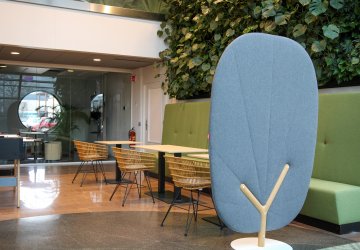
In its ”Green Quadrant® Integrated Workplace Management Systems” report, independent research firm Verdantix shares insight into the overall strategic priorities for real estate and facilities teams. One of the main priorities is space utilization. In this blogpost we share some thoughts on the topic of Space & Workplace Services Management. Is it primarily about utilization or are there other factors to take into consideration? Planon suggests you can aim for space optimization: make every Pound, Dollar, Euro, Yen or Renminbi invested in the workplace count. Not only in the context of finance, but also for the people working in it.
Space utilization management
According to Verdantix “Real estate and facilities management executives are under pressure to deliver ever-greater levels of performance across multiple fronts, whilst finding further cost savings.’’ To establish the strategic priorities for real estate and facilities teams, Verdantix interviewed their customer panel about their priority areas for improvement over the upcoming year. For more than one-third of the Verdantix customer panel, improving space utilization is the top improvement area for the next year.
“Some firms are still tackling the basics of space management, such as getting accurate and up-to-date floor plans, while other organizations are developing strategies to improve space utilization that could open the door to the consolidation of real estate space.” Given the fact that each desk can cost organizations” up to $27,000 per year and that they are often 50% underutilized, there is great untapped opportunities for cost savings in this area.
The business relevance of space and workplaces
Sometimes we forget how important a workplace is for employees and its potential impact on business results. According to ”The next 250k”, a research report from Leesman, 44% of all the employees working in an office say that their office does not strongly support them when it comes to carrying out their expected duties. Duties predominantly refers to the more standard, process-oriented aspects of work which one could denote as productivity, also known as “getting more work done”.
However, these days it has become apparent that there is another side to productivity: the ability of the organization to innovate, to do things smarter and faster than before. Innovation often comes about when people from diverse backgrounds interact and solve problems, typically resulting in completely new and different approaches. Workplaces play a facilitating role in this considering that their setup, design and the services provided can foster or inhibit innovative interactions between people: a key role in achieving great business results.
We believe that this broader definition of ”Return On Investment” around workplaces should drive assessments on how to improve space and workplace management for an organization: it is not merely an FM-financial exercise, although the finances remain a very important factor of course.
Planon’s Perspective on Space Utilization
From Planon’s point of view, the product of the building is space and the product of space is workplace. When it comes to space and workplace management, several aspects are very important: workplace capacity, workplace fit (for purpose), workplace experience and cost of ownership. Space and workplace managers need to create a balance between all these aspects. Disregarding one of them will typically lead to sub-optimization.
”Utilization” seems to primarily focus on the aspect of capacity: actual use versus availability. When utilization is very low, the obvious conclusion is that there is room for improvement. It is however not a matter of a simple equation, such as concluding that consolidation (a smaller footprint) is the solution. One needs to ask other questions: do people like to work there? Are alternatives more popular amongst the workforce and does the business regard that as desirable?
In other words: do the types of workspaces offered fit with the type of staff that they are supposed to serve? Do they really support the type of work they have? Are bad workplace experiences chasing them away? Monitoring workplace experiences of the workforce next to occupancy statistics provides insight into the actual fit of workplace supply and demand.
Cost savings in Space & Workplace Services Management
Space is typically one of the most scarce and expensive assets in the realm of Real Estate & Facility Management. It is quite understandable that cost savings in this area are foremost in the mind. It is often referred to as ”efficiency”. A prerequisite for any cost savings project is a reliable view of the portfolio of spaces, their functions, quality, areas, usage and occupancy. We regard space/workplace efficiency projects as efforts to take out elements of waste in the workplace operations. Elements of waste can include meeting spaces with a too high capacity (rooms rarely used to their capacity).
However, there exists elements of waste that are not often considered regarding workplace efficiency. Think about the quality of the workplaces when it comes to wellbeing and health, which also impact the cost of labor. We know that the total cost of operation of workplaces is only worth some 10% of the cost of salaries in an average office building in western economies. One of the strongest drivers behind wellbeing projects that we see evolving today is keeping people healthy and feeling comfortable. These aspects contribute to productivity as well as cost savings on sickness absence. This represents the economic sense behind monitoring climatic conditions around the workplace using IoT. By taking this broader position, we are effectively extending the scope of ”total cost of operation” of workplaces to encompass costs of labor, a much broader and more relevant perspective for the business.
How to make Return on Investment concrete?
To approach this, we go back to the most important aspects of workplaces: capacity, fit (for purpose), experience and cost of ownership. Investments made in space and workplaces will have to render value at least one of these aspects. An approach to consider when managing space & workplace investments is to communicate investment value in the framework of a Balanced Score Card.

Monitoring the balance between them is important since organizations continuously change: size of the workforce, expertise required, types of activities deployed in the workplace. Our own workplace preferences fundamentally change as we grow older.
When you are looking for tools to support you in managing continuous space and workplace change, a tool such as an IWMS can be helpful. Would you like to learn more about Planon’s solution for Space Management? Read our Agile Workplace Management White Paper.




















